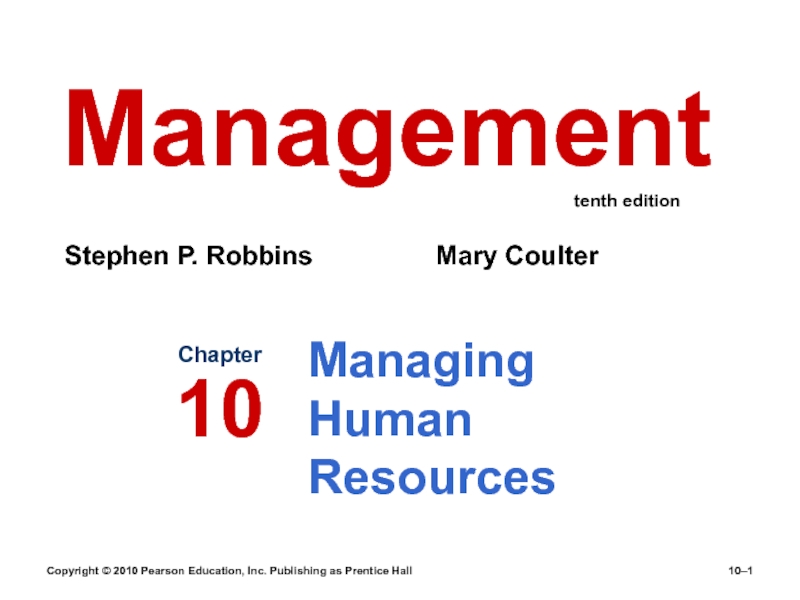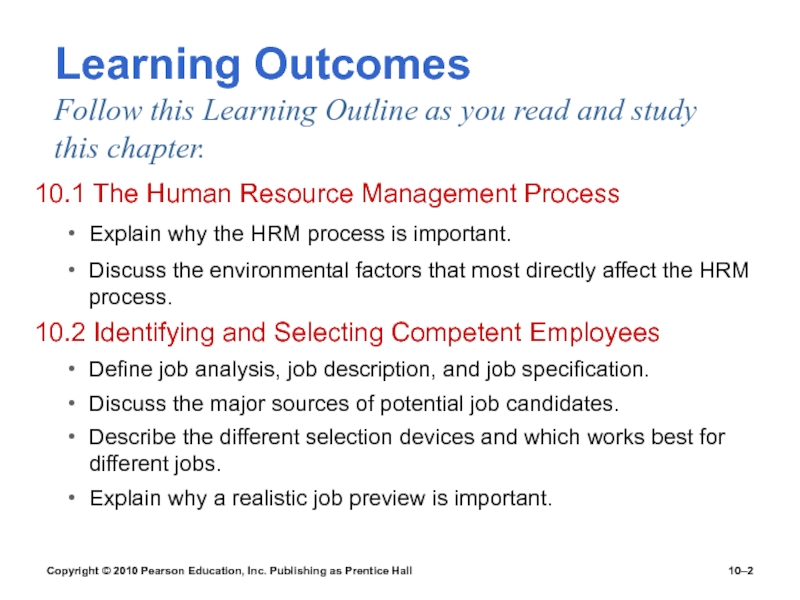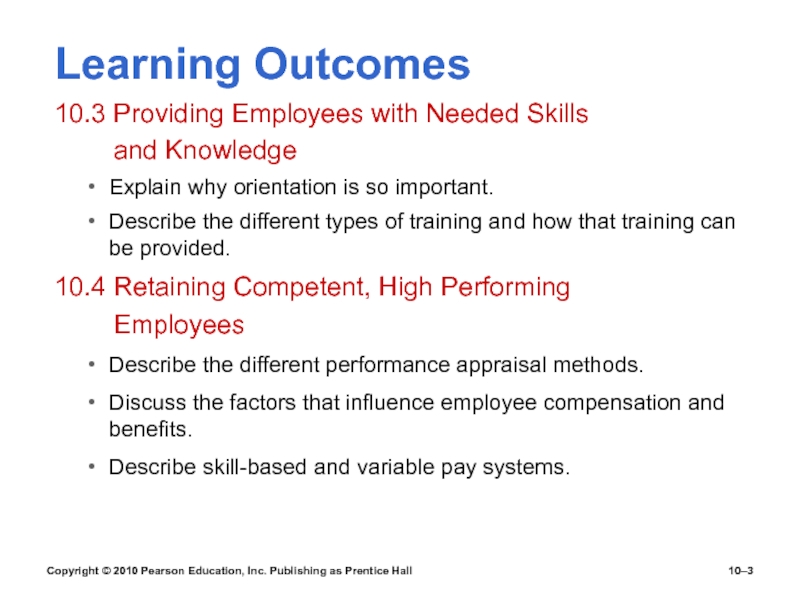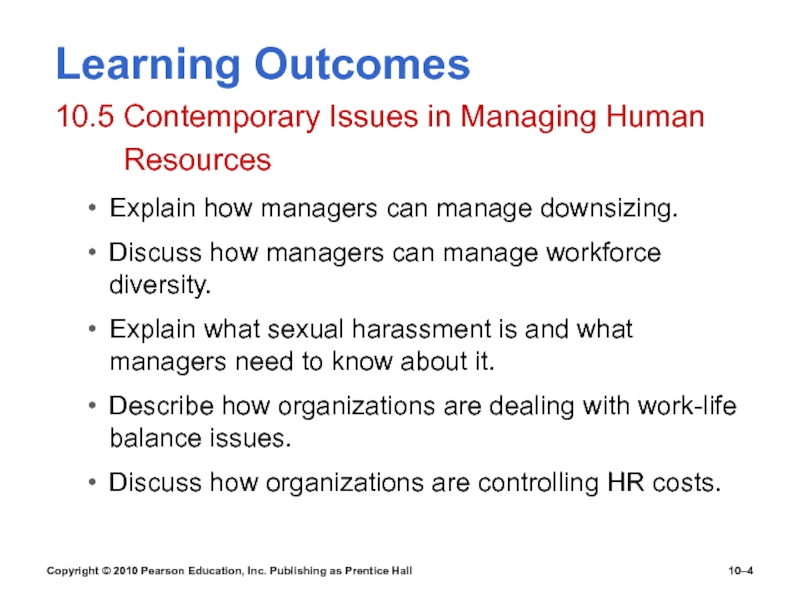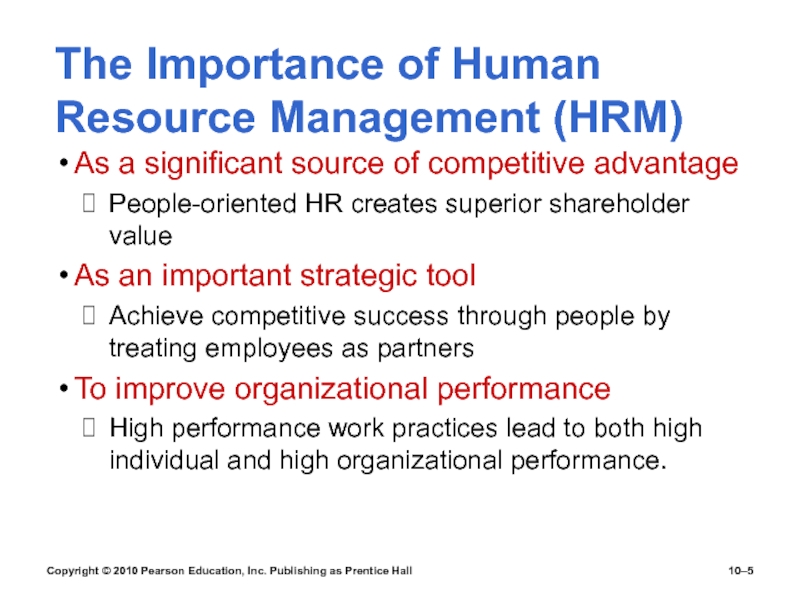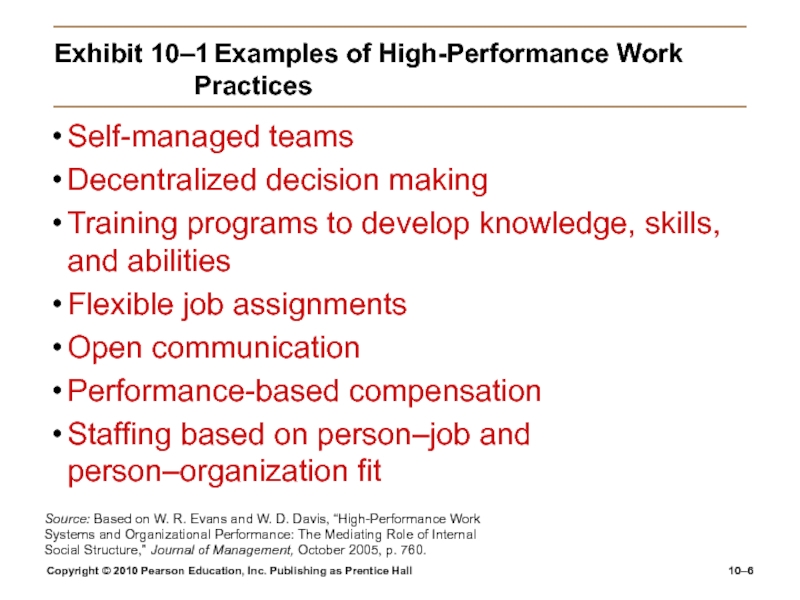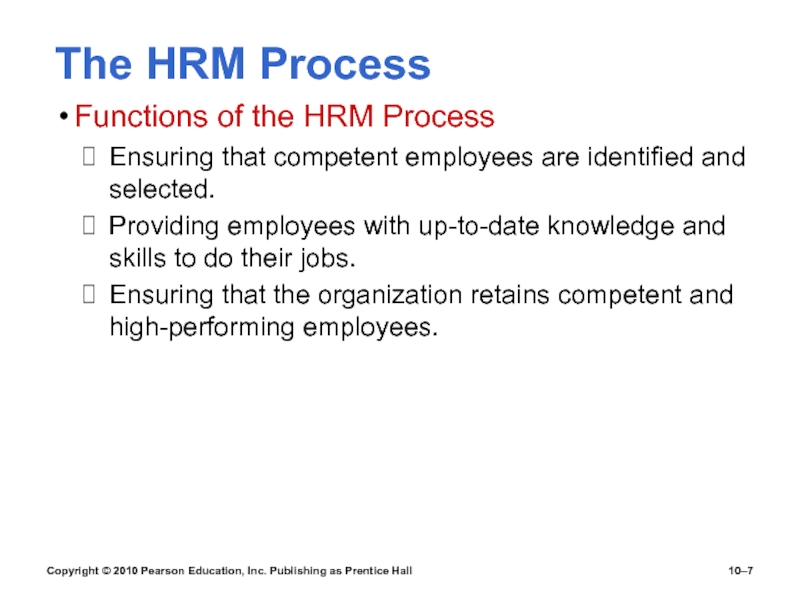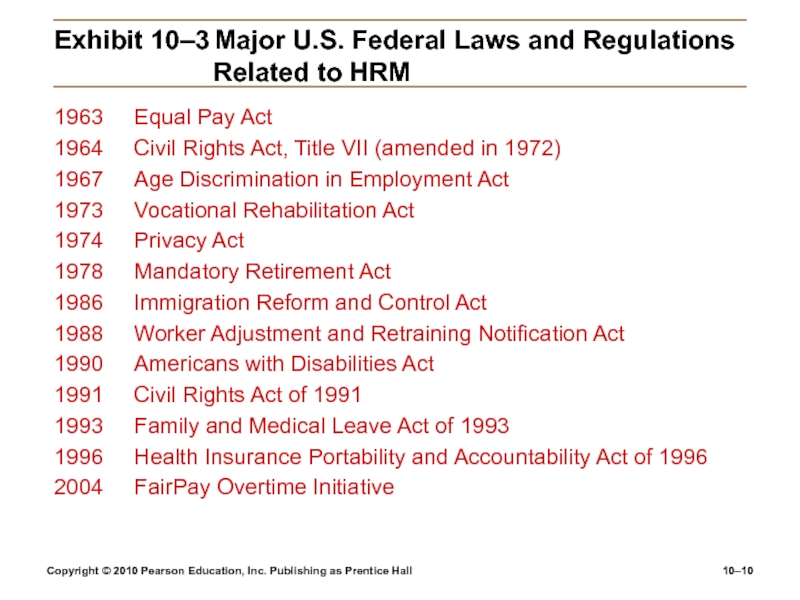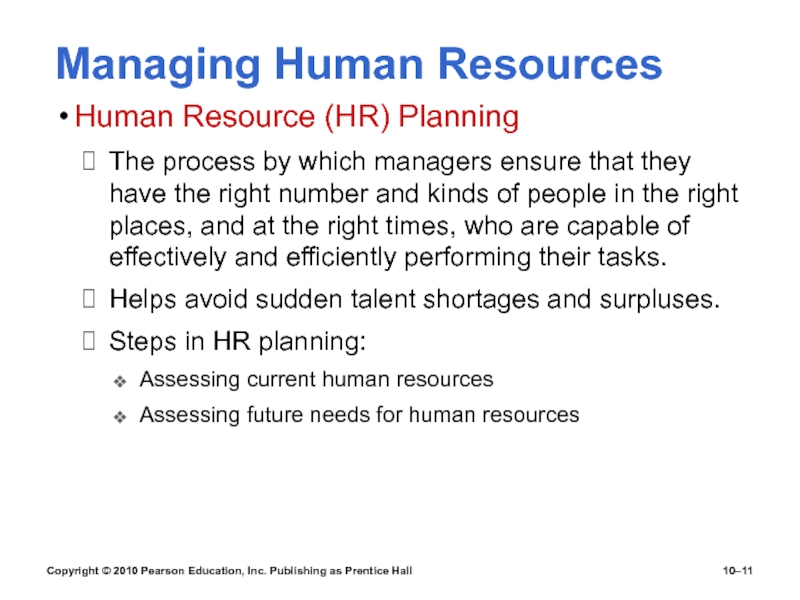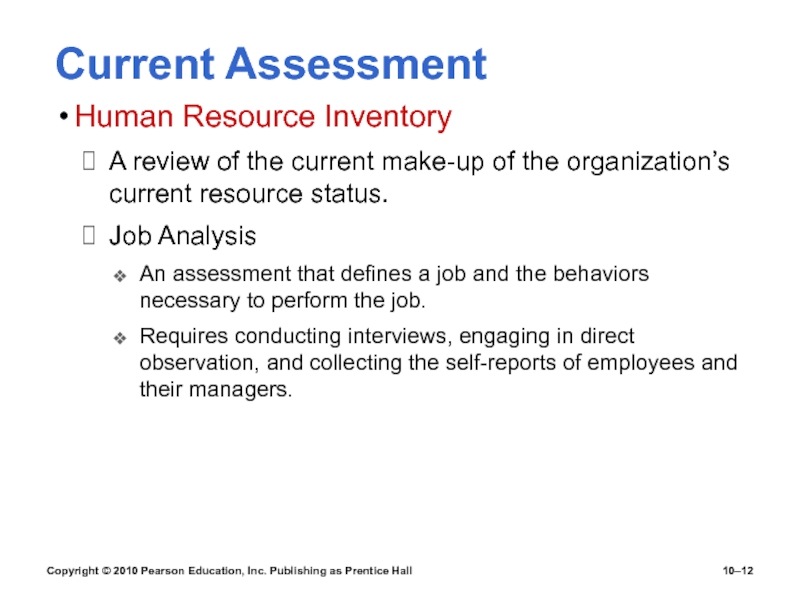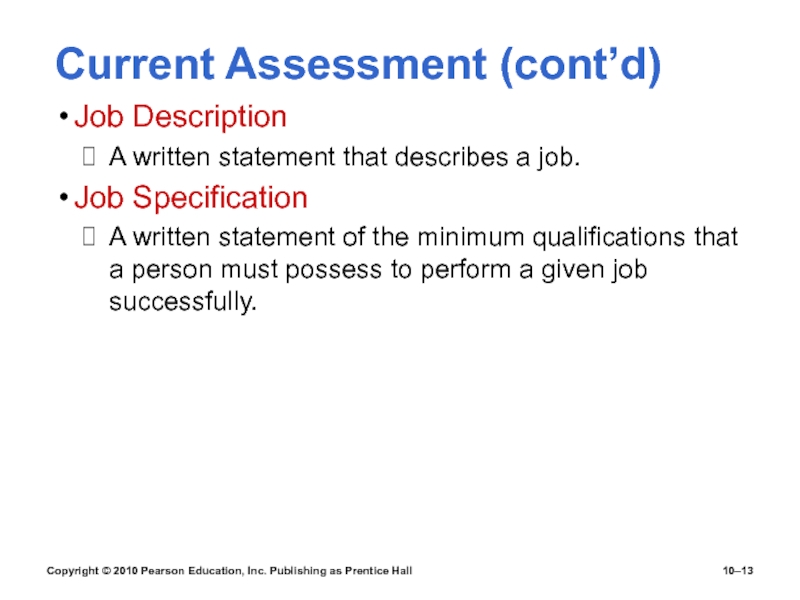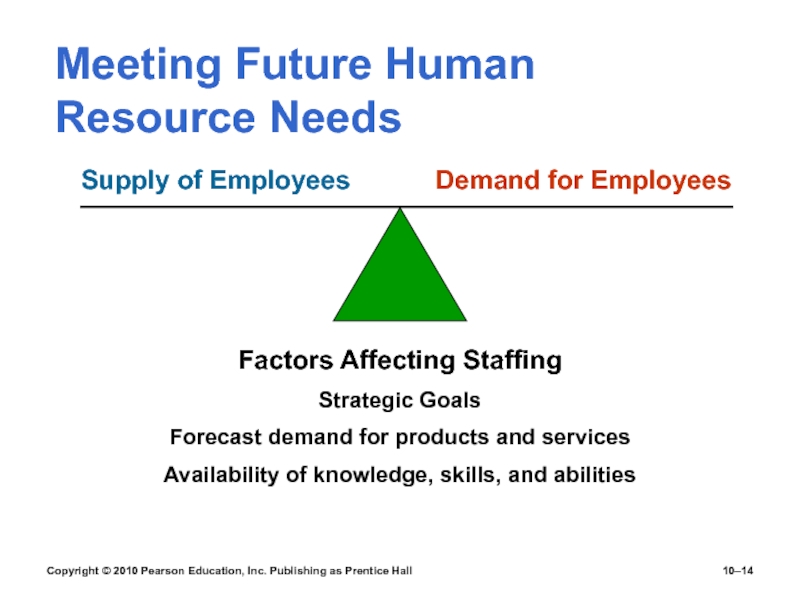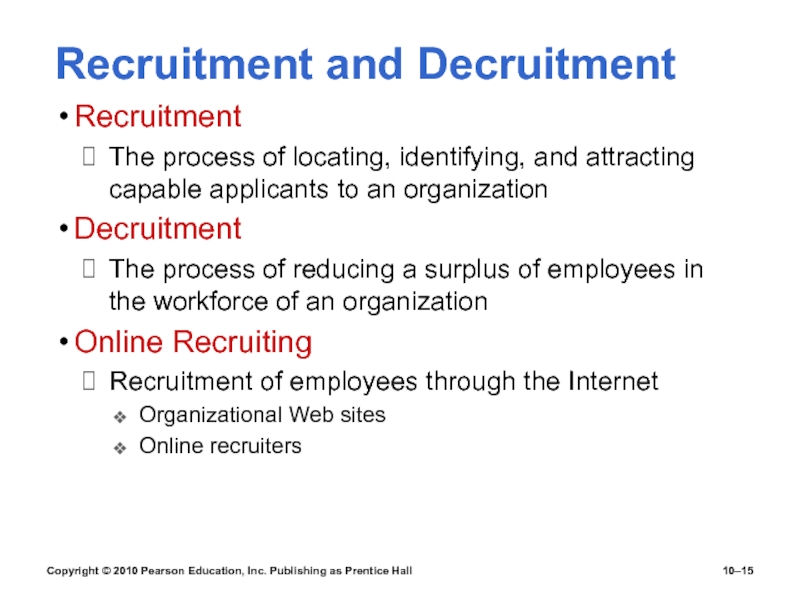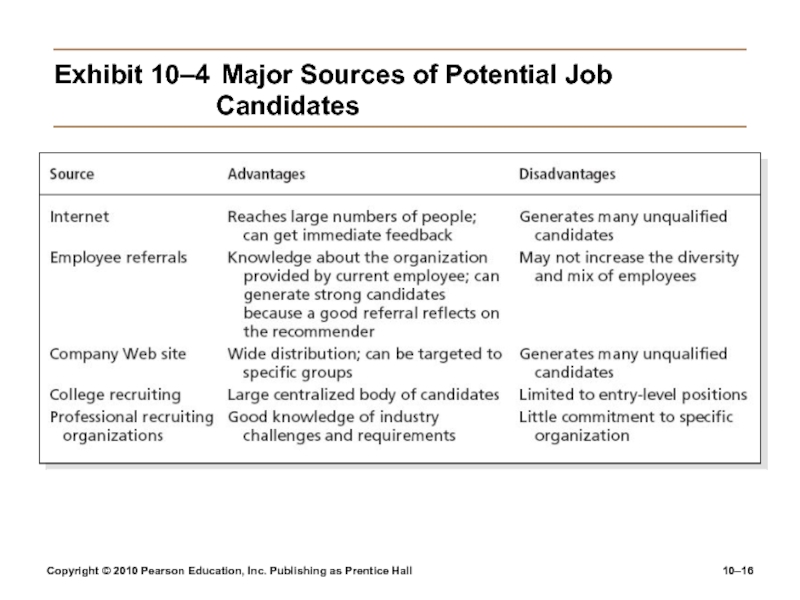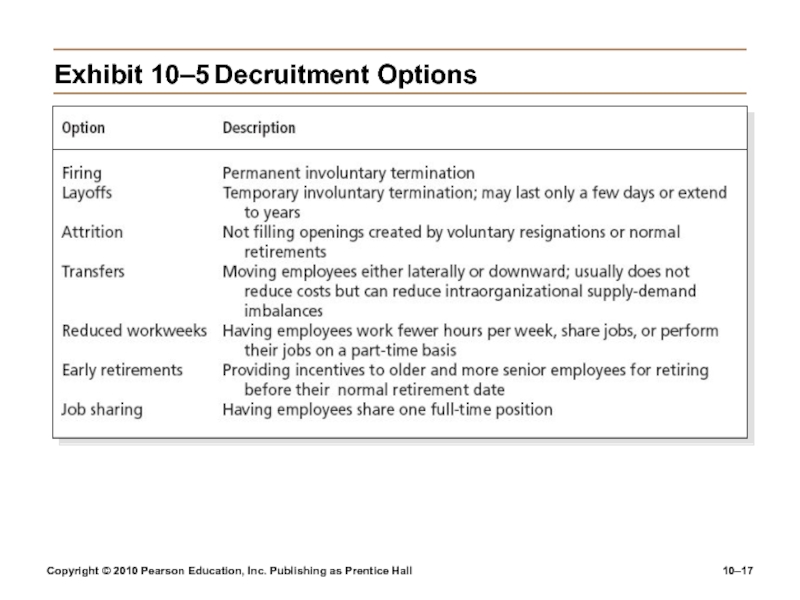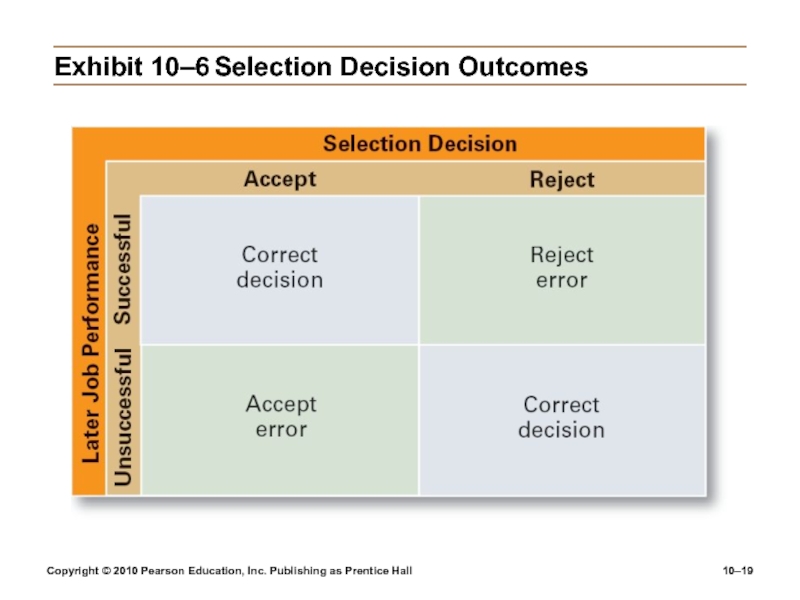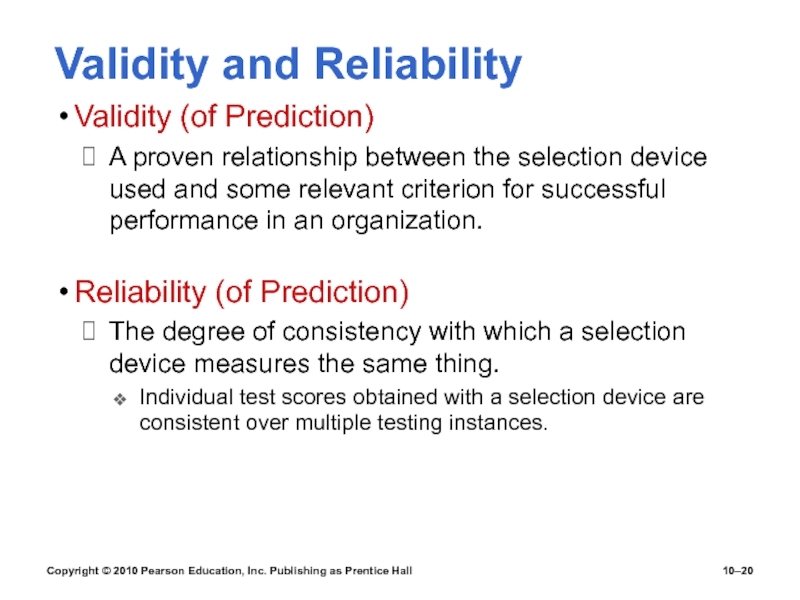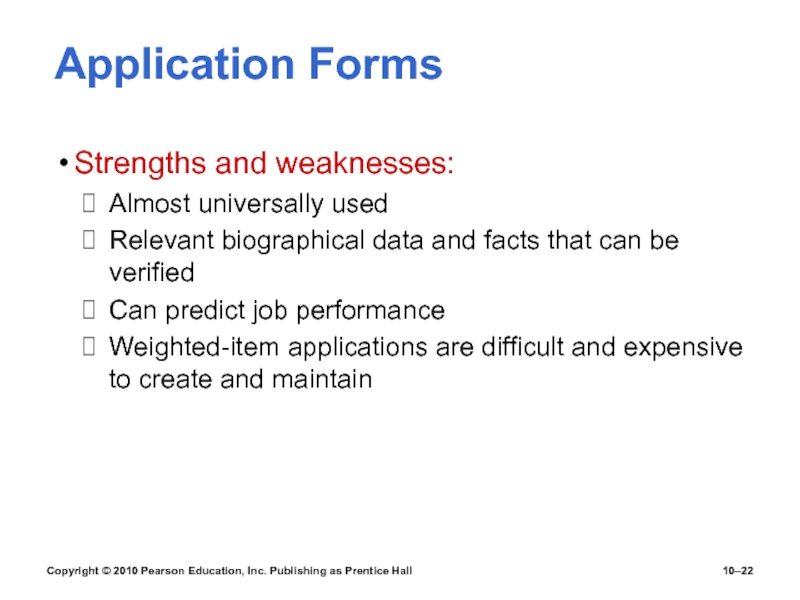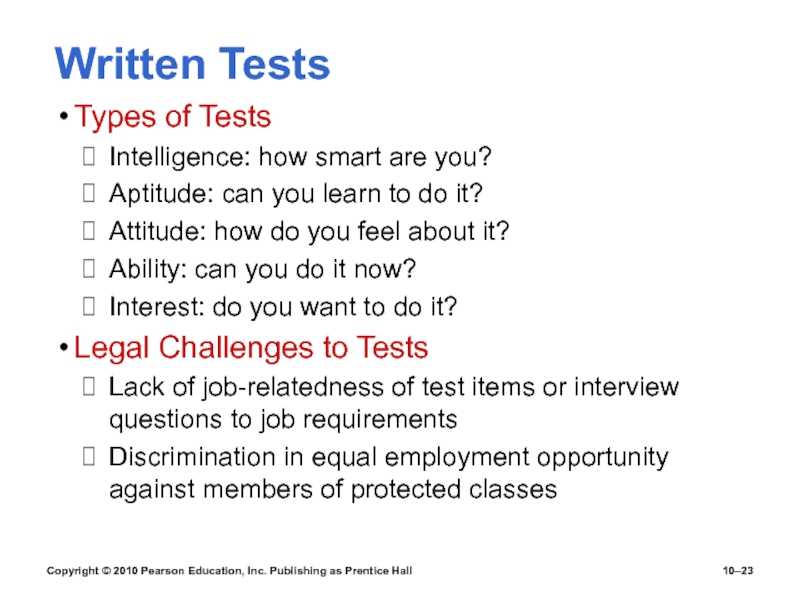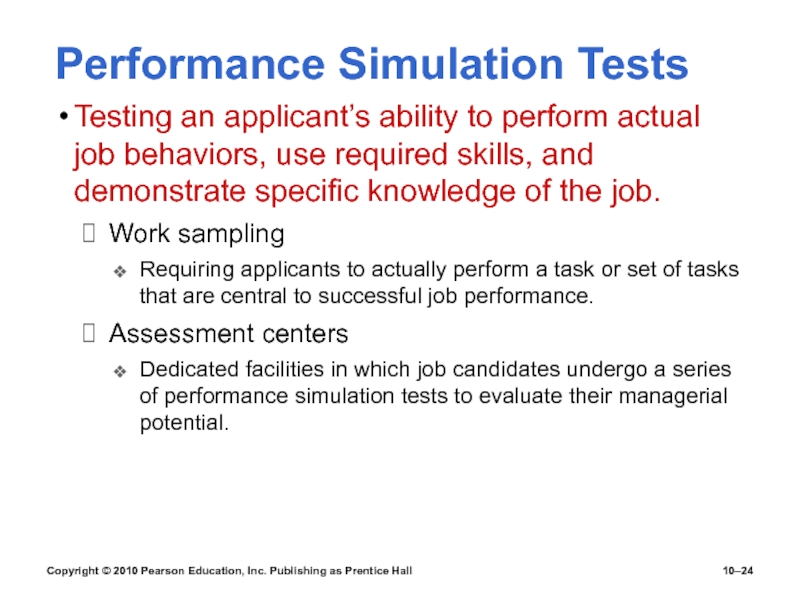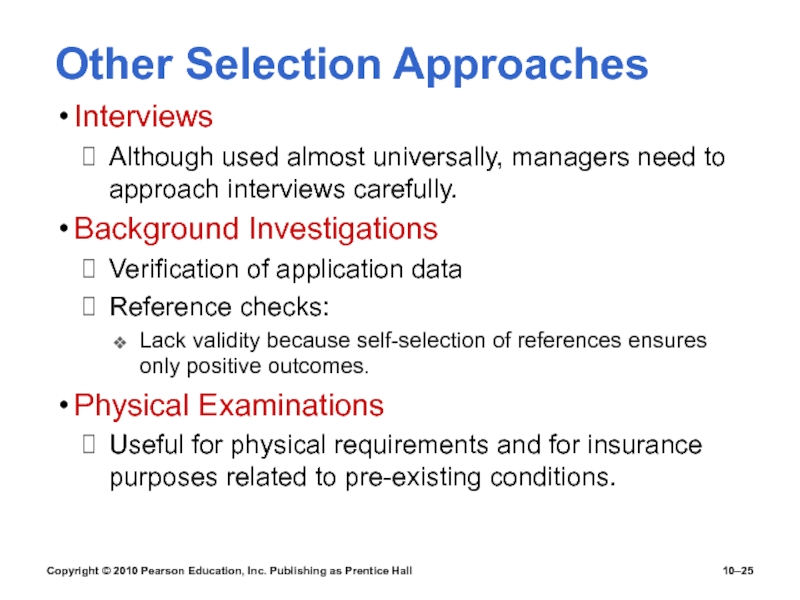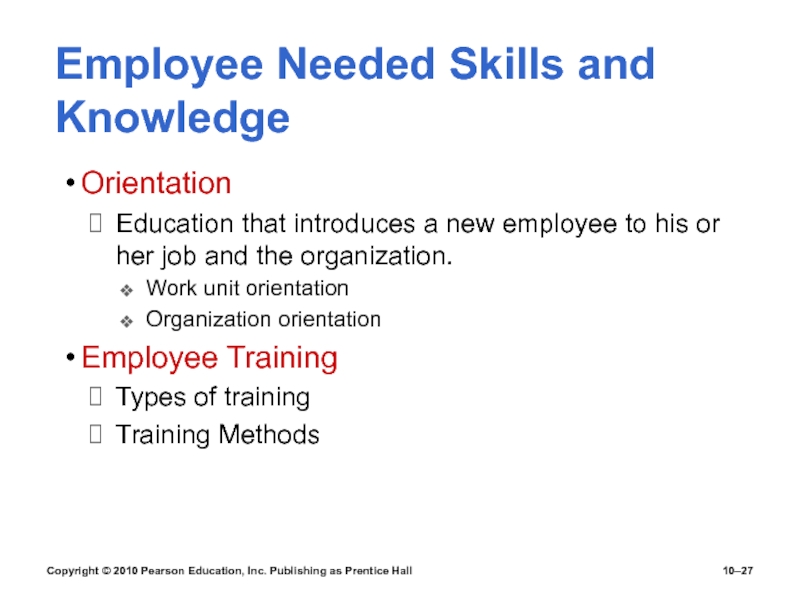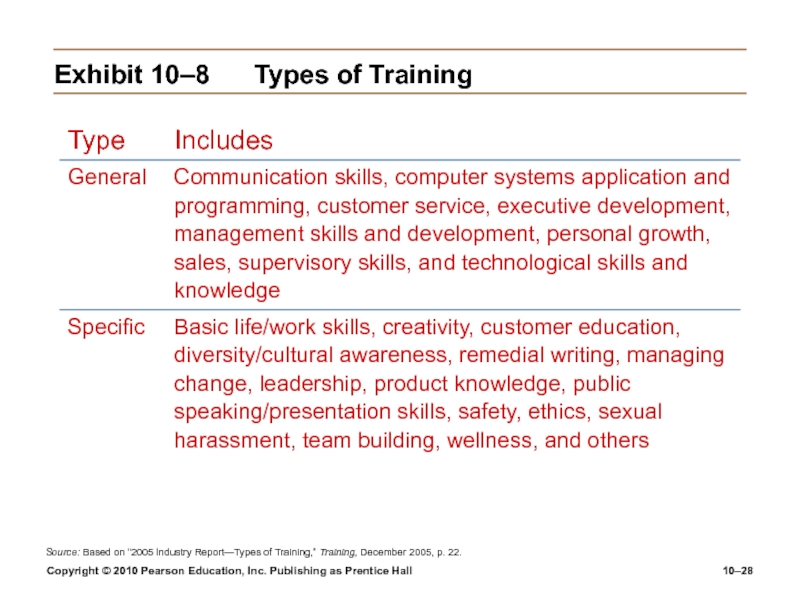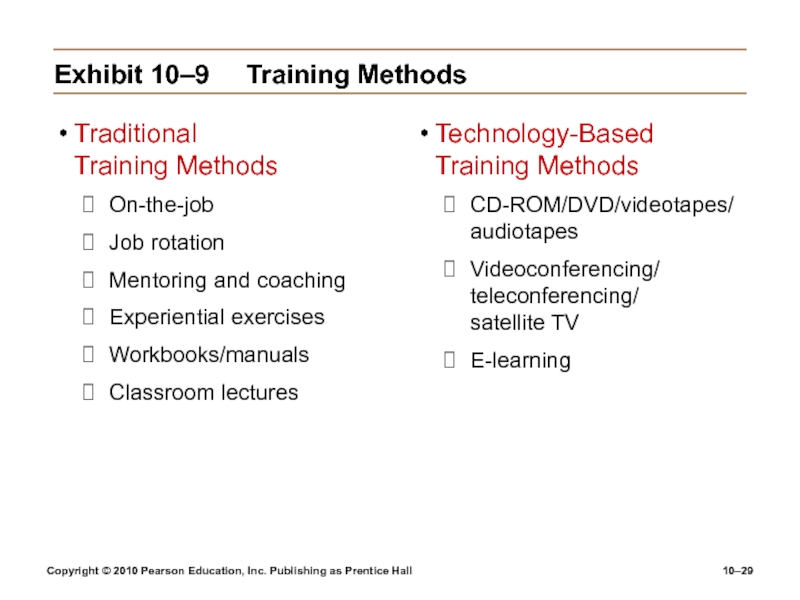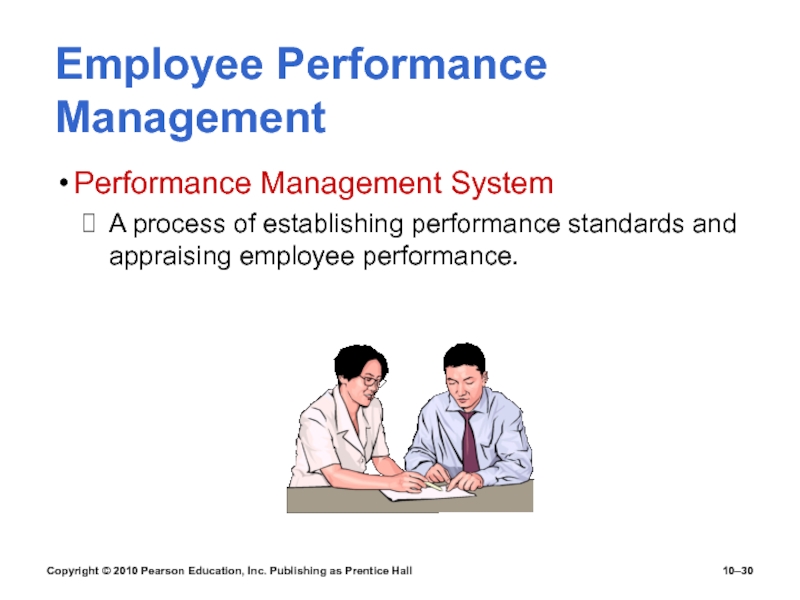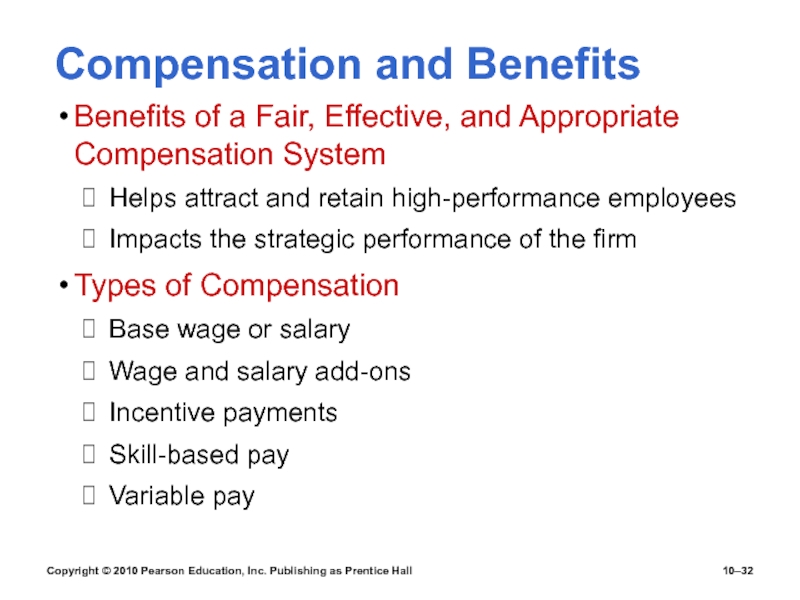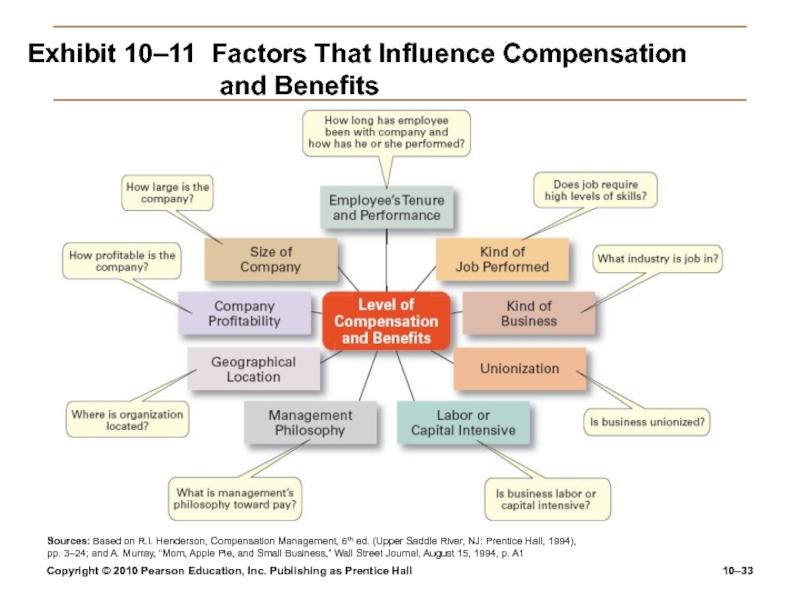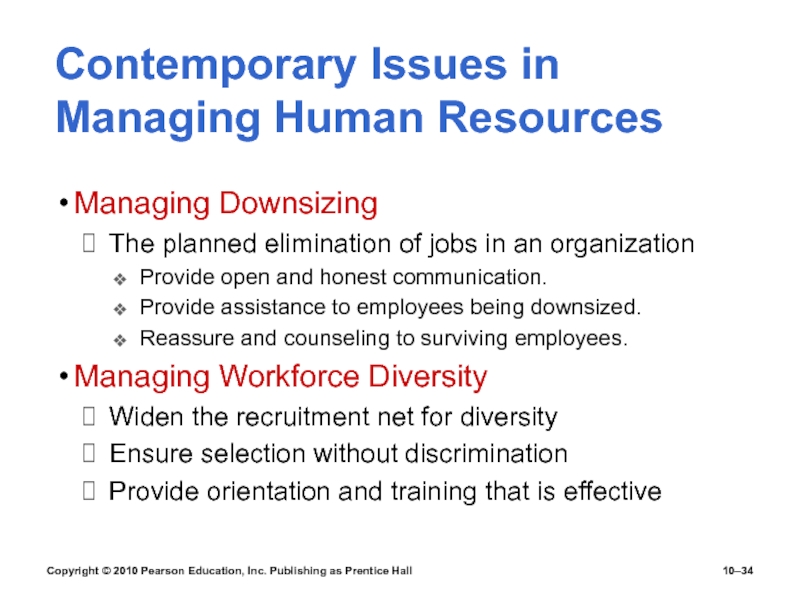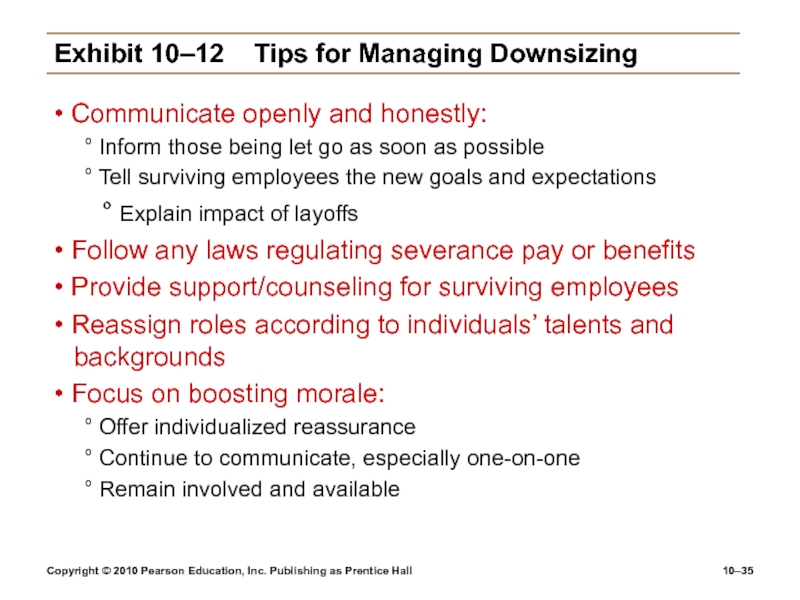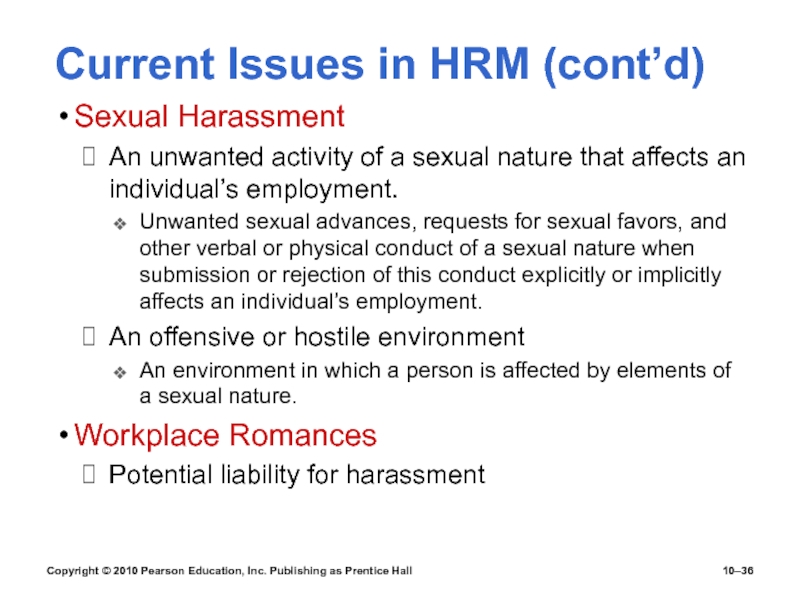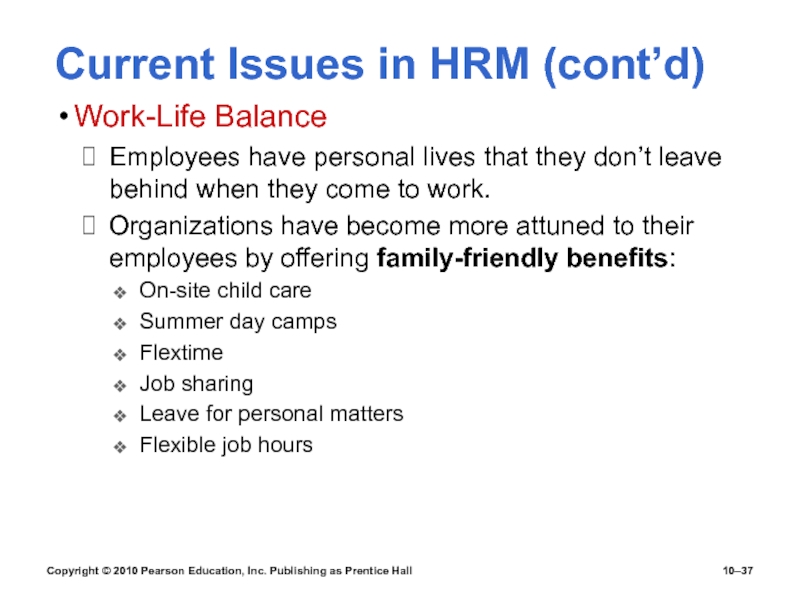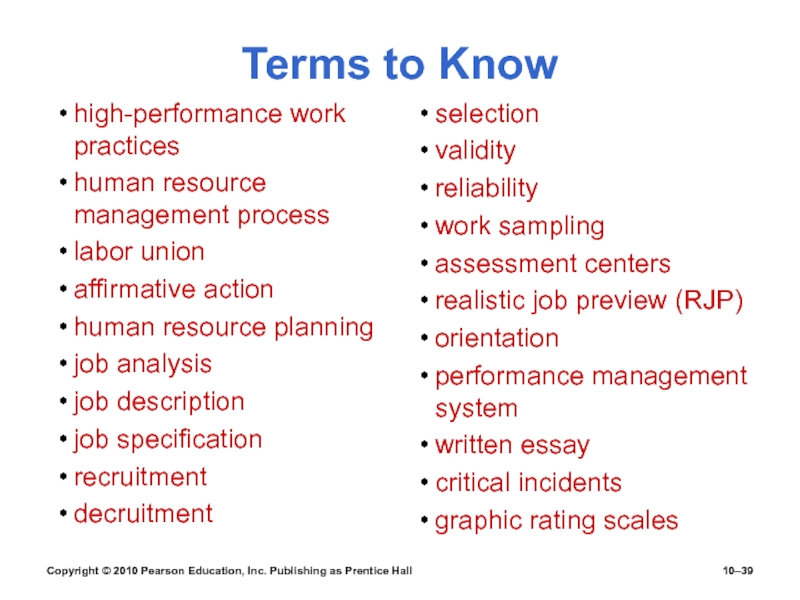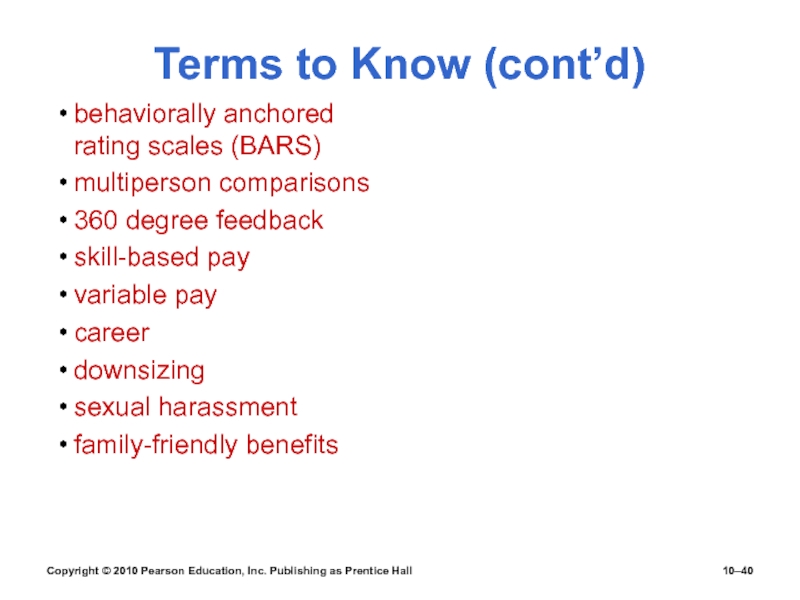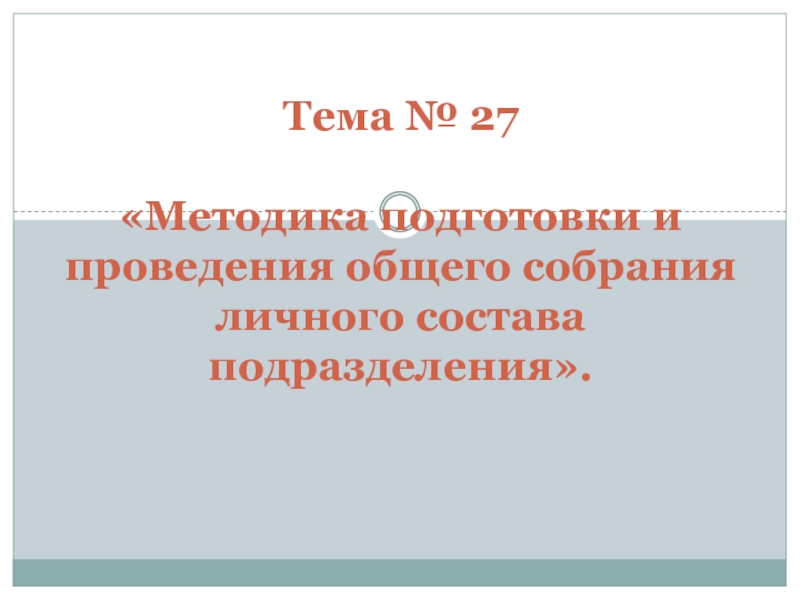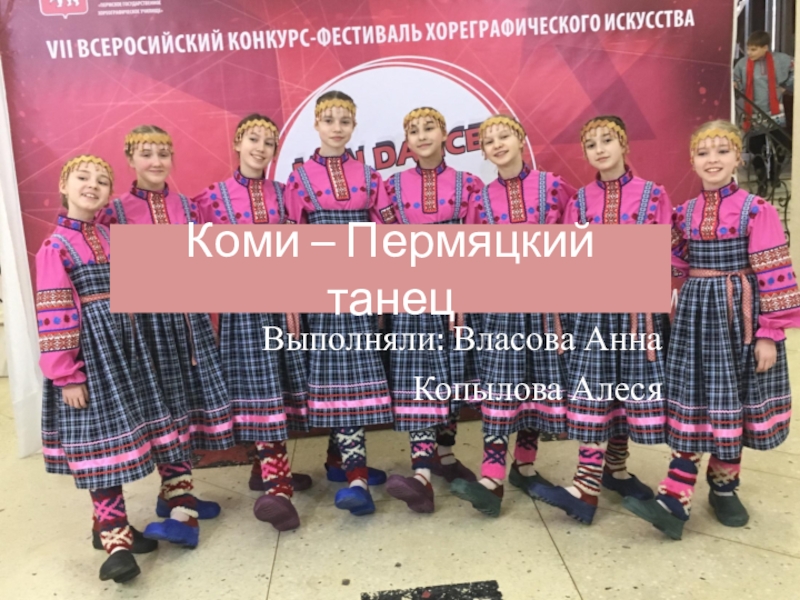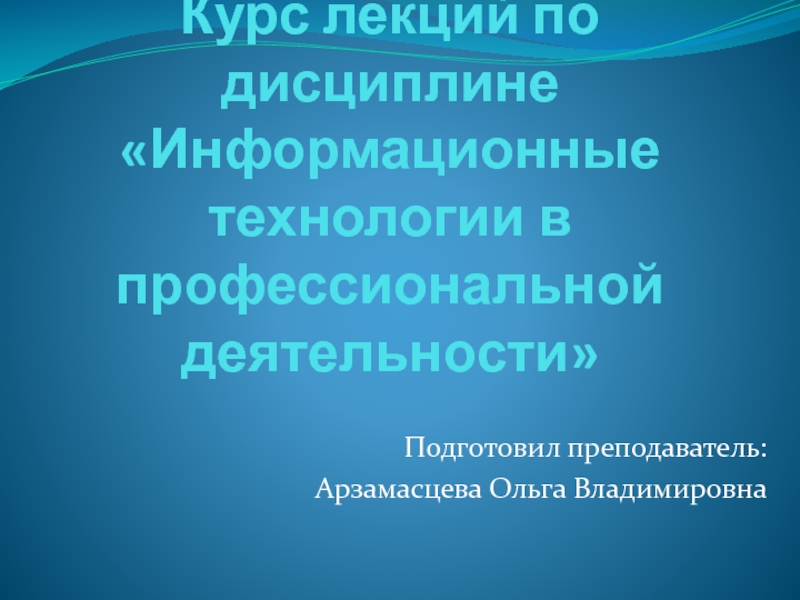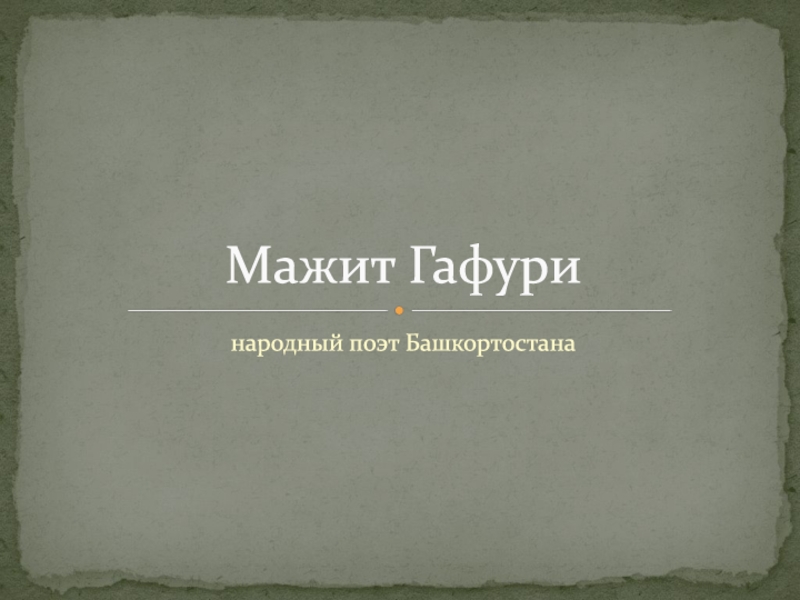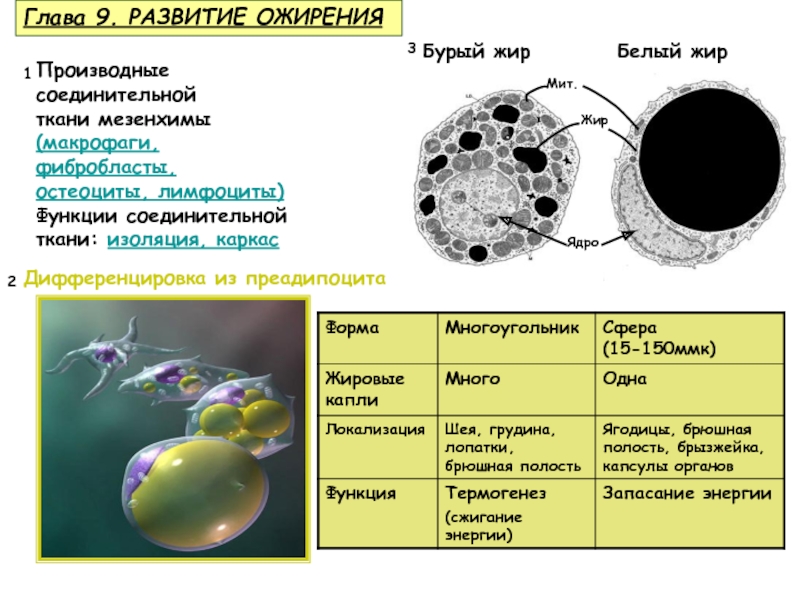Разделы презентаций
- Разное
- Английский язык
- Астрономия
- Алгебра
- Биология
- География
- Геометрия
- Детские презентации
- Информатика
- История
- Литература
- Математика
- Медицина
- Менеджмент
- Музыка
- МХК
- Немецкий язык
- ОБЖ
- Обществознание
- Окружающий мир
- Педагогика
- Русский язык
- Технология
- Физика
- Философия
- Химия
- Шаблоны, картинки для презентаций
- Экология
- Экономика
- Юриспруденция
Managing Human Resources
Содержание
- 1. Managing Human Resources
- 2. Copyright © 2010 Pearson Education, Inc. Publishing
- 3. Copyright © 2010 Pearson Education, Inc. Publishing
- 4. Copyright © 2010 Pearson Education, Inc. Publishing
- 5. Copyright © 2010 Pearson Education, Inc. Publishing
- 6. Copyright © 2010 Pearson Education, Inc. Publishing
- 7. Copyright © 2010 Pearson Education, Inc. Publishing
- 8. Copyright © 2010 Pearson Education, Inc. Publishing as Prentice Hall10–Exhibit 10–2 Human Resource Management Process
- 9. Copyright © 2010 Pearson Education, Inc. Publishing
- 10. Copyright © 2010 Pearson Education, Inc. Publishing
- 11. Copyright © 2010 Pearson Education, Inc. Publishing
- 12. Copyright © 2010 Pearson Education, Inc. Publishing
- 13. Copyright © 2010 Pearson Education, Inc. Publishing
- 14. Copyright © 2010 Pearson Education, Inc. Publishing
- 15. Copyright © 2010 Pearson Education, Inc. Publishing
- 16. Copyright © 2010 Pearson Education, Inc. Publishing
- 17. Copyright © 2010 Pearson Education, Inc. Publishing as Prentice Hall10–Exhibit 10–5 Decruitment Options
- 18. Copyright © 2010 Pearson Education, Inc. Publishing
- 19. Copyright © 2010 Pearson Education, Inc. Publishing as Prentice Hall10–Exhibit 10–6 Selection Decision Outcomes
- 20. Copyright © 2010 Pearson Education, Inc. Publishing
- 21. Copyright © 2010 Pearson Education, Inc. Publishing
- 22. Copyright © 2010 Pearson Education, Inc. Publishing
- 23. Copyright © 2010 Pearson Education, Inc. Publishing
- 24. Copyright © 2010 Pearson Education, Inc. Publishing
- 25. Copyright © 2010 Pearson Education, Inc. Publishing
- 26. Copyright © 2010 Pearson Education, Inc. Publishing
- 27. Copyright © 2010 Pearson Education, Inc. Publishing
- 28. Copyright © 2010 Pearson Education, Inc. Publishing
- 29. Copyright © 2010 Pearson Education, Inc. Publishing
- 30. Copyright © 2010 Pearson Education, Inc. Publishing
- 31. Copyright © 2010 Pearson Education, Inc. Publishing
- 32. Copyright © 2010 Pearson Education, Inc. Publishing
- 33. Copyright © 2010 Pearson Education, Inc. Publishing
- 34. Copyright © 2010 Pearson Education, Inc. Publishing
- 35. Copyright © 2010 Pearson Education, Inc. Publishing
- 36. Copyright © 2010 Pearson Education, Inc. Publishing
- 37. Copyright © 2010 Pearson Education, Inc. Publishing
- 38. Copyright © 2010 Pearson Education, Inc. Publishing
- 39. Copyright © 2010 Pearson Education, Inc. Publishing
- 40. Copyright © 2010 Pearson Education, Inc. Publishing
- 41. Copyright © 2010 Pearson Education, Inc. Publishing
- 42. Скачать презентанцию
Слайды и текст этой презентации
Слайд 1Copyright © 2010 Pearson Education, Inc. Publishing as Prentice Hall
10–
Managing
Human Resources
Слайд 2Copyright © 2010 Pearson Education, Inc. Publishing as Prentice Hall
10–
Learning
Outcomes Follow this Learning Outline as you read and study this
chapter.10.1 The Human Resource Management Process
Explain why the HRM process is important.
Discuss the environmental factors that most directly affect the HRM process.
10.2 Identifying and Selecting Competent Employees
Define job analysis, job description, and job specification.
Discuss the major sources of potential job candidates.
Describe the different selection devices and which works best for different jobs.
Explain why a realistic job preview is important.
Слайд 3Copyright © 2010 Pearson Education, Inc. Publishing as Prentice Hall
10–
Learning
Outcomes
10.3 Providing Employees with Needed Skills
and
KnowledgeExplain why orientation is so important.
Describe the different types of training and how that training can be provided.
10.4 Retaining Competent, High Performing
Employees
Describe the different performance appraisal methods.
Discuss the factors that influence employee compensation and benefits.
Describe skill-based and variable pay systems.
Слайд 4Copyright © 2010 Pearson Education, Inc. Publishing as Prentice Hall
10–
Learning
Outcomes
10.5 Contemporary Issues in Managing Human
Resources
Explain
how managers can manage downsizing.Discuss how managers can manage workforce diversity.
Explain what sexual harassment is and what managers need to know about it.
Describe how organizations are dealing with work-life balance issues.
Discuss how organizations are controlling HR costs.
Слайд 5Copyright © 2010 Pearson Education, Inc. Publishing as Prentice Hall
10–
The
Importance of Human Resource Management (HRM)
As a significant source of
competitive advantagePeople-oriented HR creates superior shareholder value
As an important strategic tool
Achieve competitive success through people by treating employees as partners
To improve organizational performance
High performance work practices lead to both high individual and high organizational performance.
Слайд 6Copyright © 2010 Pearson Education, Inc. Publishing as Prentice Hall
10–
Exhibit
10–1 Examples of High-Performance Work Practices
Self-managed teams
Decentralized decision making
Training programs to
develop knowledge, skills, and abilitiesFlexible job assignments
Open communication
Performance-based compensation
Staffing based on person–job and person–organization fit
Source: Based on W. R. Evans and W. D. Davis, “High-Performance Work Systems and Organizational Performance: The Mediating Role of Internal Social Structure,” Journal of Management, October 2005, p. 760.
Слайд 7Copyright © 2010 Pearson Education, Inc. Publishing as Prentice Hall
10–
The
HRM Process
Functions of the HRM Process
Ensuring that competent employees are
identified and selected.Providing employees with up-to-date knowledge and skills to do their jobs.
Ensuring that the organization retains competent and high-performing employees.
Слайд 8Copyright © 2010 Pearson Education, Inc. Publishing as Prentice Hall
10–
Exhibit
10–2 Human Resource Management Process
Слайд 9Copyright © 2010 Pearson Education, Inc. Publishing as Prentice Hall
10–
Environmental
Factors Affecting HRM
Employee Labor Unions
Organizations that represent workers and seek
to protect their interests through collective bargaining.Collective bargaining agreement
A contractual agreement between a firm and a union elected to represent a bargaining unit of employees of the firm in bargaining for wage, hours, and working conditions.
Governmental Laws and Regulations
Limit managerial discretion in hiring, promoting, and discharging employees.
Affirmative Action: Organizational programs that enhance the status of members of protected groups.
Слайд 10Copyright © 2010 Pearson Education, Inc. Publishing as Prentice Hall
10–
Exhibit
10–3 Major U.S. Federal Laws and Regulations Related to
HRM1963 Equal Pay Act
1964 Civil Rights Act, Title VII (amended in 1972)
1967 Age Discrimination in Employment Act
1973 Vocational Rehabilitation Act
1974 Privacy Act
1978 Mandatory Retirement Act
1986 Immigration Reform and Control Act
1988 Worker Adjustment and Retraining Notification Act
1990 Americans with Disabilities Act
1991 Civil Rights Act of 1991
1993 Family and Medical Leave Act of 1993
1996 Health Insurance Portability and Accountability Act of 1996
2004 FairPay Overtime Initiative
Слайд 11Copyright © 2010 Pearson Education, Inc. Publishing as Prentice Hall
10–
Managing
Human Resources
Human Resource (HR) Planning
The process by which managers ensure
that they have the right number and kinds of people in the right places, and at the right times, who are capable of effectively and efficiently performing their tasks.Helps avoid sudden talent shortages and surpluses.
Steps in HR planning:
Assessing current human resources
Assessing future needs for human resources
Слайд 12Copyright © 2010 Pearson Education, Inc. Publishing as Prentice Hall
10–
Current
Assessment
Human Resource Inventory
A review of the current make-up of the
organization’s current resource status.Job Analysis
An assessment that defines a job and the behaviors necessary to perform the job.
Requires conducting interviews, engaging in direct observation, and collecting the self-reports of employees and their managers.
Слайд 13Copyright © 2010 Pearson Education, Inc. Publishing as Prentice Hall
10–
Current
Assessment (cont’d)
Job Description
A written statement that describes a job.
Job Specification
A
written statement of the minimum qualifications that a person must possess to perform a given job successfully.Слайд 14Copyright © 2010 Pearson Education, Inc. Publishing as Prentice Hall
10–
Meeting
Future Human Resource Needs
Factors Affecting Staffing
Strategic Goals
Forecast demand for products
and servicesAvailability of knowledge, skills, and abilities
Слайд 15Copyright © 2010 Pearson Education, Inc. Publishing as Prentice Hall
10–
Recruitment
and Decruitment
Recruitment
The process of locating, identifying, and attracting capable applicants
to an organizationDecruitment
The process of reducing a surplus of employees in the workforce of an organization
Online Recruiting
Recruitment of employees through the Internet
Organizational Web sites
Online recruiters
Слайд 16Copyright © 2010 Pearson Education, Inc. Publishing as Prentice Hall
10–
Exhibit
10–4 Major Sources of Potential Job
Candidates
Слайд 17Copyright © 2010 Pearson Education, Inc. Publishing as Prentice Hall
10–
Exhibit
10–5 Decruitment Options
Слайд 18Copyright © 2010 Pearson Education, Inc. Publishing as Prentice Hall
10–
Selection
Selection
Process
The process of screening job applicants to ensure that the
most appropriate candidates are hired.What is Selection?
An exercise in predicting which applicants, if hired, will be (or will not be) successful in performing well on the criteria the organization uses to evaluate performance.
Selection errors:
Reject errors for potentially successful applicants
Accept errors for ultimately poor performers
Слайд 19Copyright © 2010 Pearson Education, Inc. Publishing as Prentice Hall
10–
Exhibit
10–6 Selection Decision Outcomes
Слайд 20Copyright © 2010 Pearson Education, Inc. Publishing as Prentice Hall
10–
Validity
and Reliability
Validity (of Prediction)
A proven relationship between the selection device
used and some relevant criterion for successful performance in an organization.Reliability (of Prediction)
The degree of consistency with which a selection device measures the same thing.
Individual test scores obtained with a selection device are consistent over multiple testing instances.
Слайд 21Copyright © 2010 Pearson Education, Inc. Publishing as Prentice Hall
10–
Exhibit
10–7 Selection Tools
Application Forms
Written Tests
Performance Simulations Tests
Interviews
Background Investigations
Physical Examinations
Слайд 22Copyright © 2010 Pearson Education, Inc. Publishing as Prentice Hall
10–
Application
Forms
Strengths and weaknesses:
Almost universally used
Relevant biographical data and facts that
can be verifiedCan predict job performance
Weighted-item applications are difficult and expensive to create and maintain
Слайд 23Copyright © 2010 Pearson Education, Inc. Publishing as Prentice Hall
10–
Written
Tests
Types of Tests
Intelligence: how smart are you?
Aptitude: can you learn
to do it?Attitude: how do you feel about it?
Ability: can you do it now?
Interest: do you want to do it?
Legal Challenges to Tests
Lack of job-relatedness of test items or interview questions to job requirements
Discrimination in equal employment opportunity against members of protected classes
Слайд 24Copyright © 2010 Pearson Education, Inc. Publishing as Prentice Hall
10–
Performance
Simulation Tests
Testing an applicant’s ability to perform actual job behaviors,
use required skills, and demonstrate specific knowledge of the job.Work sampling
Requiring applicants to actually perform a task or set of tasks that are central to successful job performance.
Assessment centers
Dedicated facilities in which job candidates undergo a series of performance simulation tests to evaluate their managerial potential.
Слайд 25Copyright © 2010 Pearson Education, Inc. Publishing as Prentice Hall
10–
Other
Selection Approaches
Interviews
Although used almost universally, managers need to approach interviews
carefully.Background Investigations
Verification of application data
Reference checks:
Lack validity because self-selection of references ensures only positive outcomes.
Physical Examinations
Useful for physical requirements and for insurance purposes related to pre-existing conditions.
Слайд 26Copyright © 2010 Pearson Education, Inc. Publishing as Prentice Hall
10–
Other
Selection Approaches (cont’d)
Realistic Job Preview (RJP)
The process of relating to
an applicant both the positive and the negative aspects of the job.Encourages mismatched applicants to withdraw.
Aligns successful applicants’ expectations with actual job conditions, reducing turnover.
Слайд 27Copyright © 2010 Pearson Education, Inc. Publishing as Prentice Hall
10–
Employee
Needed Skills and Knowledge
Orientation
Education that introduces a new employee to
his or her job and the organization.Work unit orientation
Organization orientation
Employee Training
Types of training
Training Methods
Слайд 28Copyright © 2010 Pearson Education, Inc. Publishing as Prentice Hall
10–
Exhibit
10–8 Types of Training
Source: Based on “2005 Industry Report—Types of
Training,” Training, December 2005, p. 22.Слайд 29Copyright © 2010 Pearson Education, Inc. Publishing as Prentice Hall
10–
Exhibit
10–9 Training Methods
Traditional
Training Methods
On-the-job
Job rotation
Mentoring and coaching
Experiential
exercisesWorkbooks/manuals
Classroom lectures
Technology-Based Training Methods
CD-ROM/DVD/videotapes/ audiotapes
Videoconferencing/ teleconferencing/
satellite TV
E-learning
Слайд 30Copyright © 2010 Pearson Education, Inc. Publishing as Prentice Hall
10–
Employee
Performance Management
Performance Management System
A process of establishing performance standards and
appraising employee performance. Слайд 31Copyright © 2010 Pearson Education, Inc. Publishing as Prentice Hall
10–
Exhibit
10–10 Advantages and Disadvantages of Performance
Appraisal MethodsСлайд 32Copyright © 2010 Pearson Education, Inc. Publishing as Prentice Hall
10–
Compensation
and Benefits
Benefits of a Fair, Effective, and Appropriate Compensation System
Helps
attract and retain high-performance employeesImpacts the strategic performance of the firm
Types of Compensation
Base wage or salary
Wage and salary add-ons
Incentive payments
Skill-based pay
Variable pay
Слайд 33Copyright © 2010 Pearson Education, Inc. Publishing as Prentice Hall
10–
Exhibit
10–11 Factors That Influence Compensation
and BenefitsSources: Based on R.I. Henderson, Compensation Management, 6th ed. (Upper Saddle River, NJ: Prentice Hall, 1994), pp. 3–24; and A. Murray, “Mom, Apple Pie, and Small Business,” Wall Street Journal, August 15, 1994, p. A1
Слайд 34Copyright © 2010 Pearson Education, Inc. Publishing as Prentice Hall
10–
Contemporary
Issues in Managing Human Resources
Managing Downsizing
The planned elimination of jobs
in an organizationProvide open and honest communication.
Provide assistance to employees being downsized.
Reassure and counseling to surviving employees.
Managing Workforce Diversity
Widen the recruitment net for diversity
Ensure selection without discrimination
Provide orientation and training that is effective
Слайд 35Copyright © 2010 Pearson Education, Inc. Publishing as Prentice Hall
10–
Exhibit
10–12 Tips for Managing Downsizing
• Communicate openly and honestly:
°
Inform those being let go as soon as possible° Tell surviving employees the new goals and expectations
° Explain impact of layoffs
• Follow any laws regulating severance pay or benefits
• Provide support/counseling for surviving employees
• Reassign roles according to individuals’ talents and backgrounds
• Focus on boosting morale:
° Offer individualized reassurance
° Continue to communicate, especially one-on-one
° Remain involved and available
Слайд 36Copyright © 2010 Pearson Education, Inc. Publishing as Prentice Hall
10–
Current
Issues in HRM (cont’d)
Sexual Harassment
An unwanted activity of a sexual
nature that affects an individual’s employment.Unwanted sexual advances, requests for sexual favors, and other verbal or physical conduct of a sexual nature when submission or rejection of this conduct explicitly or implicitly affects an individual’s employment.
An offensive or hostile environment
An environment in which a person is affected by elements of a sexual nature.
Workplace Romances
Potential liability for harassment
Слайд 37Copyright © 2010 Pearson Education, Inc. Publishing as Prentice Hall
10–
Current
Issues in HRM (cont’d)
Work-Life Balance
Employees have personal lives that they
don’t leave behind when they come to work.Organizations have become more attuned to their employees by offering family-friendly benefits:
On-site child care
Summer day camps
Flextime
Job sharing
Leave for personal matters
Flexible job hours
Слайд 38Copyright © 2010 Pearson Education, Inc. Publishing as Prentice Hall
10–
Current
Issues in HRM (cont’d)
Controlling HR Costs
Employee health care
Encouraging healthy lifestyles
Financial
incentivesWellness programs
Charging employees with poor health habits more for benefits
Employee pension plans
Reducing pension benefits
No longer providing pension plans
Слайд 39Copyright © 2010 Pearson Education, Inc. Publishing as Prentice Hall
10–
Terms
to Know
high-performance work practices
human resource management process
labor union
affirmative action
human resource
planningjob analysis
job description
job specification
recruitment
decruitment
selection
validity
reliability
work sampling
assessment centers
realistic job preview (RJP)
orientation
performance management system
written essay
critical incidents
graphic rating scales
Слайд 40Copyright © 2010 Pearson Education, Inc. Publishing as Prentice Hall
10–
Terms
to Know (cont’d)
behaviorally anchored rating scales (BARS)
multiperson comparisons
360 degree feedback
skill-based
pay variable pay
career
downsizing
sexual harassment
family-friendly benefits
